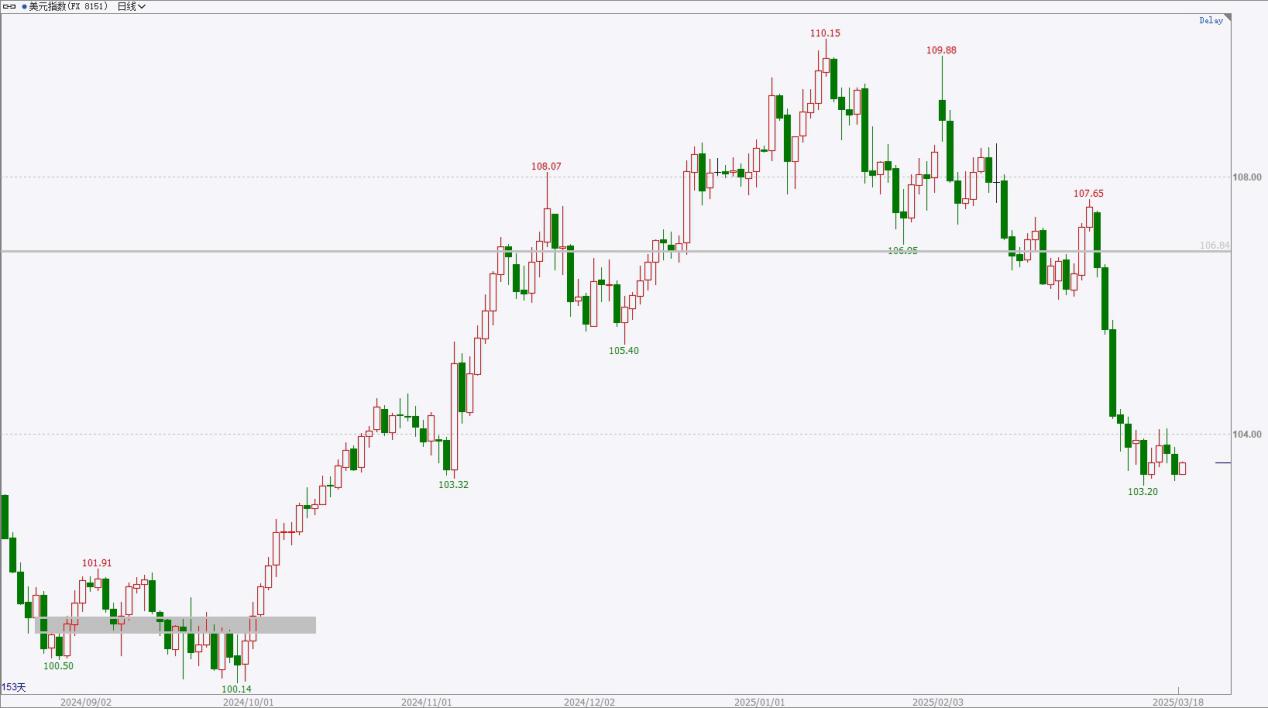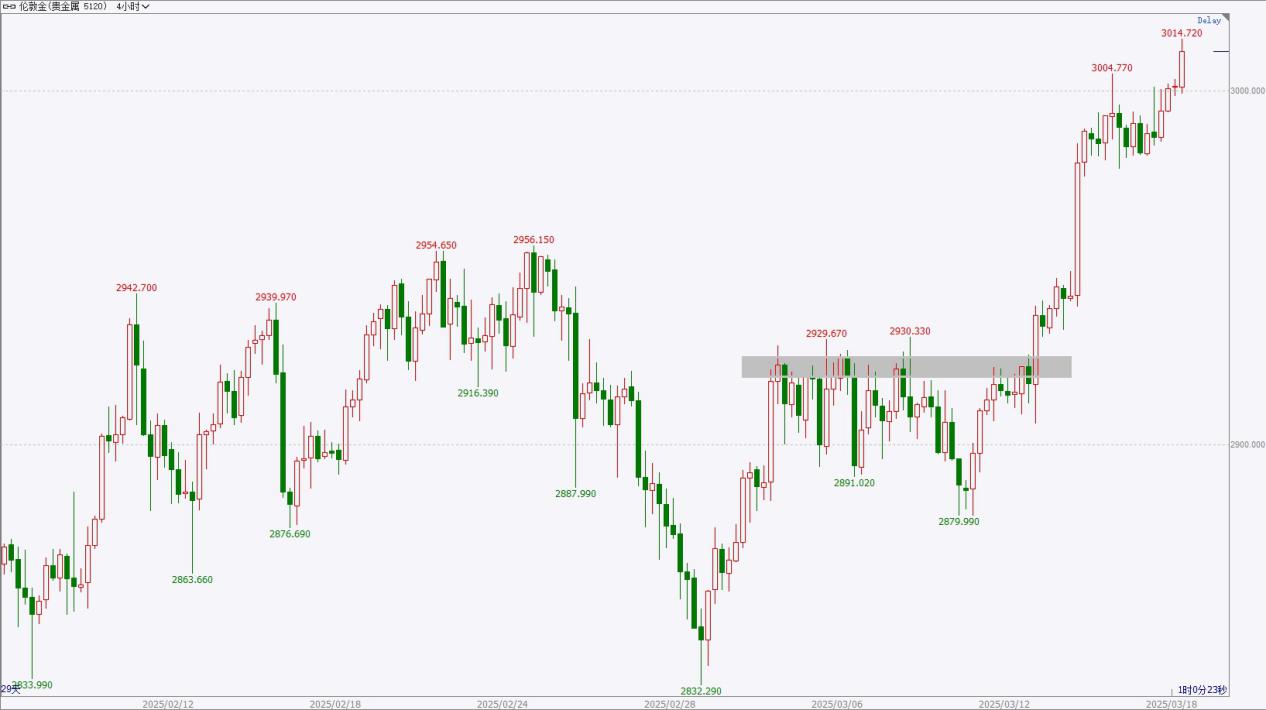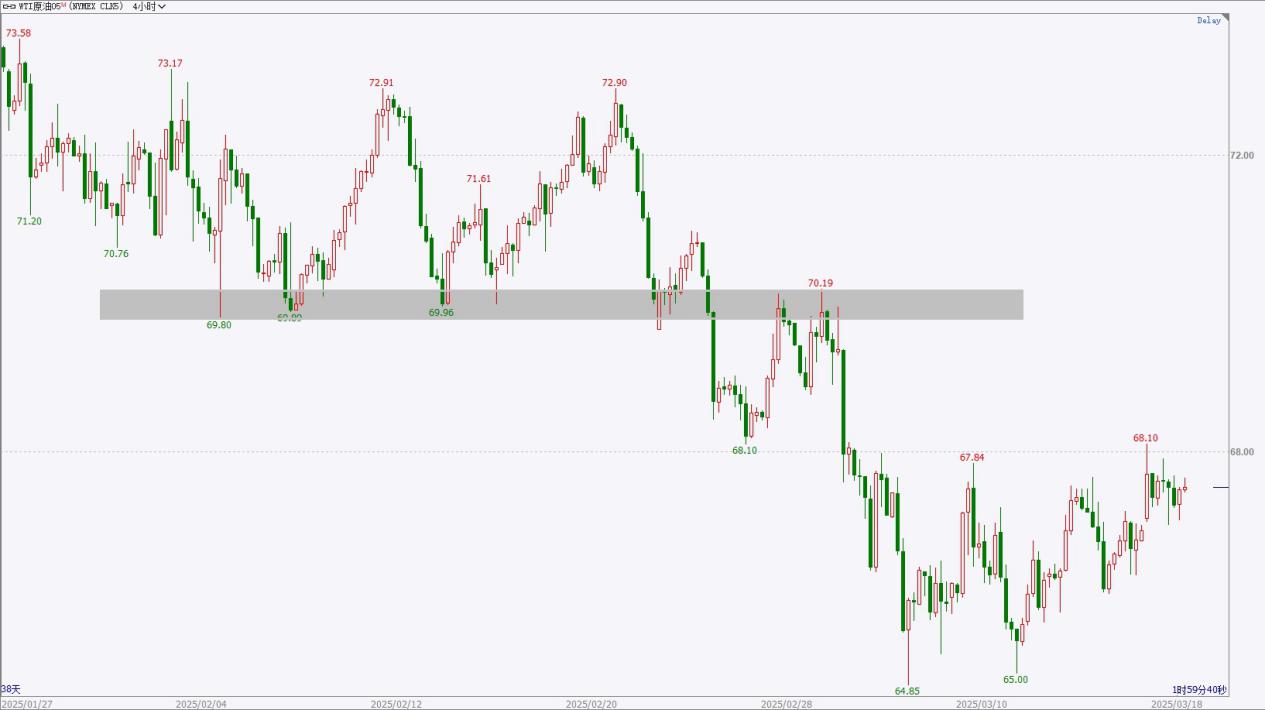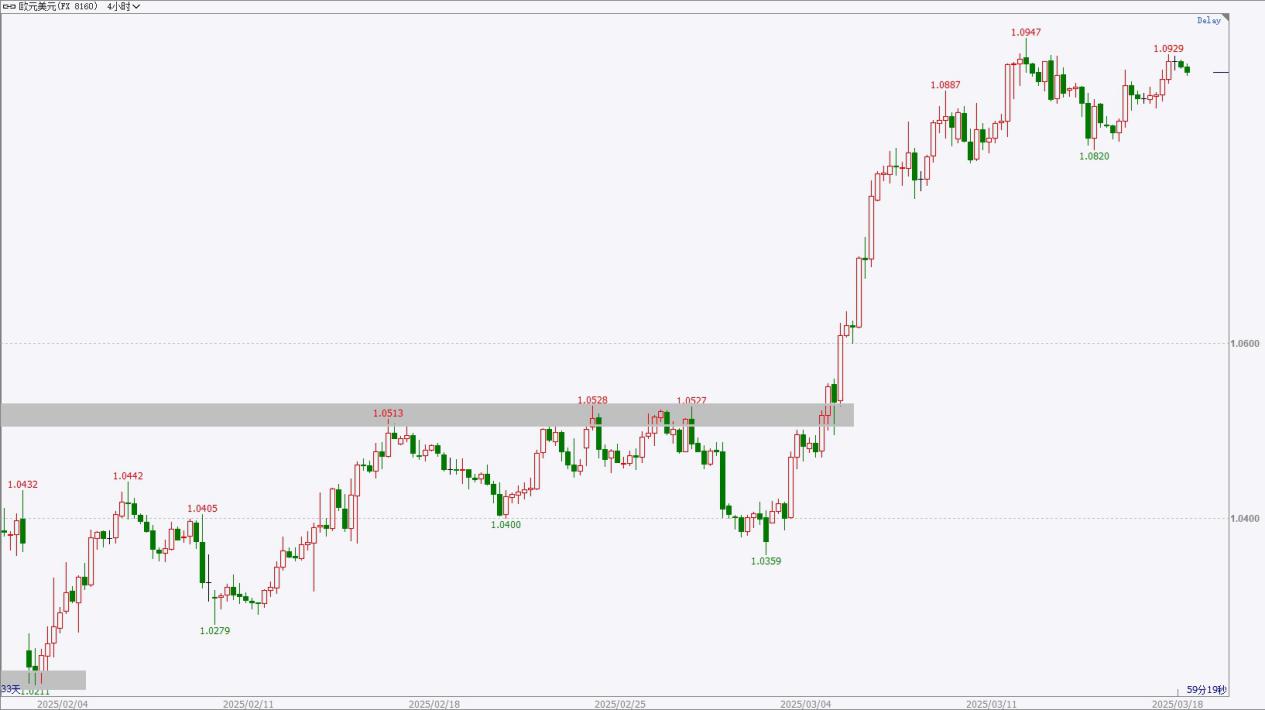|
Time
|
Data and events
|
Importance
|
|
18:00
|
Germany’s ZEW Economic Sentiment Index for March
|
★★★
|
|
Eurozone’s ZEW Economic Sentiment Index for March
|
★★★
|
|
Eurozone’s seasonally adjusted trade balance for January
|
★★★
|
|
20:30
|
Canada’s CPI month-on-month for February
|
★★★
|
|
U.S. housing starts annualized for February
|
★★★
|
|
U.S. building permits total for February
|
★★★
|
|
U.S. import price index month-on-month for February
|
★★★
|
|
21:15
|
U.S. industrial production month-on-month for February
|
★★★
|
|
Variety
|
Views
|
Support range
|
Resistance range
|
|
U.S. Dollar Index
|
Weak oscillation
|
101-102
|
106-107
|
|
Gold
|
Strong oscillation
|
2900-2930
|
3030-3050
|
|
Crude oil
|
Short-term oscillation
|
65-66
|
70-71
|
|
Euro
|
Strong oscillation
|
1.0750-1.0800
|
1.0950-1.1000
|
*Pre-market views, time-sensitive and limited in scope, are predictions for reference and learning purposes only, not constituting investment advice. The operational risks are to be borne by the investor. Investment involves risks; trading requires caution.
Fundamental analysis:
At the end of January, the Federal Reserve meeting decided to maintain interest rates unchanged, with a strong labor market and robust economic activity. Inflation levels remain slightly elevated, expectations for monetary policy easing have tapered, and new government policies will be monitored. In February, the Non-Farm Payroll data recorded an increase of 151,000 jobs, slightly below expectations, while the unemployment rate edged up. The non-seasonally adjusted CPI annual rate for February was recorded at 2.8%, marginally lower than previous values and forecasts. The core PCE price index annual rate for January slightly retreated to meet expectations. Attention should be paid to the Federal Reserve’s interest rate decision on Thursday morning.
Technical analysis:

The U.S. Dollar Index slightly retreated during night trading, showing a minor oscillation structure, with a slowdown in the decline but no signs of stabilization yet; the market may rebound. If short positions are present, consider taking profits by reducing positions at lows, while paying attention to any signs of stabilization. Overall, it appears that after high-level oscillations, there are signs of weakening, and a short-term continuation of bearish pullbacks is likely. Resistance is around 106-107, while support is near 101-102.
Viewpoint: Weak oscillation, indications of consolidation in the short term; if stabilized, a rebound may occur.
*Pre-market views, time-sensitive and limited in scope, are predictions for reference and learning purposes only, not constituting investment advice. The operational risks are to be borne by the investor. Investment involves risks; trading requires caution.
Fundamental analysis:
The geopolitical conflicts in the Middle East continue to worsen, while the Eastern European situation is easing, resulting in uncertainty. The European Central Bank’s interest rate decision in early March involved a further rate cut of 25 basis points for the fifth consecutive time; inflation progress is on track, but risks to economic growth are skewed downward. The Federal Reserve maintained interest rates at the end of January, noting good economic activity but persistent high inflation levels, which eased rate cut expectations. The U.S. February Non-Farm Payroll data showed slight easing, with job additions marginally below expectations, and the unemployment rate marginally increased to 4.1%. The non-seasonally adjusted CPI annual rate for February was recorded at 2.8%, slightly lower than anticipated. The upcoming Federal Reserve interest rate decision is noteworthy.
Technical analysis:

Gold prices continued to show strength yesterday, with a short-term upward oscillation and no signs of weakening. If long positions exist, consider taking profits at highs while the short-term outlook remains strong, mainly adopting a buy-on-dips strategy. On a larger scale, the upward structure remains intact, with daily oscillation that might signal a correction; caution against market pullbacks is advised. Resistance may be near 3030-3050, while support might be around 2980.
Viewpoint: Strong oscillation; profits on long positions should be taken at highs, prioritizing the buy-on-dips strategy.
*Pre-market views, time-sensitive and limited in scope, are predictions for reference and learning purposes only, not constituting investment advice. The operational risks are to be borne by the investor. Investment involves risks; trading requires caution.
Fundamental analysis:
The March EIA monthly report basically maintains the oil price forecast for 2025 and slightly raises the global oil demand growth expectation for 2026; the OPEC monthly report keeps the global oil demand growth expectations unchanged for this year and the next; the IEA monthly report slightly lowers the global oil demand growth expectations for 2025. At the beginning of February, the OPEC+ meeting adhered to the previous oil production agreement, and the committee agreed to gradually increase oil production starting from April 1, in line with prior plans. The EIA crude oil inventory has slightly increased, which may put pressure on oil prices, with attention on data changes.
Technical analysis:

US crude oil saw a slight rise and then a retreat yesterday, with a short-term oscillating structure. The current price is at a relatively low level, so it is not advisable to short; if there are short positions, it is better to reduce holdings and take profits on dips, while also watching for any signs of stabilization, as the market may rebound then. Overall, oil prices are oscillating and correcting at a low level, with no signs of stabilization observed. The upper pressure area is around 70-71 and the lower support area is around 65-66.
Point of view: Short-term oscillation near the support area, there may be a rebound in the market.
*Pre-market views, time-sensitive and limited in scope, are predictions for reference and learning purposes only, not constituting investment advice. The operational risks are to be borne by the investor. Investment involves risks; trading requires caution.
Fundamental analysis:
The European Central Bank’s interest rate decision at the beginning of March saw a continuous fifth 25 basis point rate cut, with inflation retreating smoothly, and a slight downward adjustment in GDP growth forecasts for this year and next; economic growth risks are tilted downwards, and tariffs may have negative impacts. At the end of January, the Federal Reserve decided to keep interest rates unchanged, with overall economic performance being strong and easing expectations subsiding. The non-farm payroll data in the U.S. for February showed a slight easing, with new job numbers slightly below expectations and the unemployment rate rising slightly to 4.1%. There was little change in the manufacturing PMI in the Eurozone. Attention is on the Federal Reserve’s interest rate decision.
Technical analysis:

The euro price oscillated slightly during the day, with a short-term test of previous highs, but has not shown a clear breakthrough. There may be selling pressure above; if there are long positions, it is advisable to reduce holdings and take profits on highs, while being cautious of potential short-term corrections. Overall, the price is at a relatively low level, with a daily oscillating structure, and may show signs of a larger stabilization. The upper pressure area is near 1.0950-1.1000, and the lower support area is near 1.0750-1.0800.
Point of view: Oscillation biased towards strength; reduce holdings and take profits on highs for long positions, while being wary of potential short-term corrections.
*Pre-market views, time-sensitive and limited in scope, are predictions for reference and learning purposes only, not constituting investment advice. The operational risks are to be borne by the investor. Investment involves risks; trading requires caution.


Daily Reviews
Our award-winning team of analysts provides keen and insightful technical and fundamental analysis to understand daily market news and investment trading opportunities
HTFX Daily Forex Commentary 0318
Time
Data and events
Importance
18:00
Germany’s ZEW Economic Sentiment Index for March
★★★
Eurozone’s ZEW Economic Sentiment Index for March
★★★
Eurozone’s seasonally adjusted trade balance for January
★★★
20:30
Canada’s CPI month-on-month for February
★★★
U.S. housing starts annualized for February
★★★
U.S. building permits total for February
★★★
U.S. import price index month-on-month for February
★★★
21:15
U.S. industrial production month-on-month for February
★★★
Variety
Views
Support range
Resistance range
U.S. Dollar Index
Weak oscillation
101-102
106-107
Gold
Strong oscillation
2900-2930
3030-3050
Crude oil
Short-term oscillation
65-66
70-71
Euro
Strong oscillation
1.0750-1.0800
1.0950-1.1000
*Pre-market views, time-sensitive and limited in scope, are predictions for reference and learning purposes only, not constituting investment advice. The operational risks are to be borne by the investor. Investment involves risks; trading requires caution.
Fundamental analysis:
At the end of January, the Federal Reserve meeting decided to maintain interest rates unchanged, with a strong labor market and robust economic activity. Inflation levels remain slightly elevated, expectations for monetary policy easing have tapered, and new government policies will be monitored. In February, the Non-Farm Payroll data recorded an increase of 151,000 jobs, slightly below expectations, while the unemployment rate edged up. The non-seasonally adjusted CPI annual rate for February was recorded at 2.8%, marginally lower than previous values and forecasts. The core PCE price index annual rate for January slightly retreated to meet expectations. Attention should be paid to the Federal Reserve’s interest rate decision on Thursday morning.
Technical analysis:
The U.S. Dollar Index slightly retreated during night trading, showing a minor oscillation structure, with a slowdown in the decline but no signs of stabilization yet; the market may rebound. If short positions are present, consider taking profits by reducing positions at lows, while paying attention to any signs of stabilization. Overall, it appears that after high-level oscillations, there are signs of weakening, and a short-term continuation of bearish pullbacks is likely. Resistance is around 106-107, while support is near 101-102.
Viewpoint: Weak oscillation, indications of consolidation in the short term; if stabilized, a rebound may occur.
*Pre-market views, time-sensitive and limited in scope, are predictions for reference and learning purposes only, not constituting investment advice. The operational risks are to be borne by the investor. Investment involves risks; trading requires caution.
Fundamental analysis:
The geopolitical conflicts in the Middle East continue to worsen, while the Eastern European situation is easing, resulting in uncertainty. The European Central Bank’s interest rate decision in early March involved a further rate cut of 25 basis points for the fifth consecutive time; inflation progress is on track, but risks to economic growth are skewed downward. The Federal Reserve maintained interest rates at the end of January, noting good economic activity but persistent high inflation levels, which eased rate cut expectations. The U.S. February Non-Farm Payroll data showed slight easing, with job additions marginally below expectations, and the unemployment rate marginally increased to 4.1%. The non-seasonally adjusted CPI annual rate for February was recorded at 2.8%, slightly lower than anticipated. The upcoming Federal Reserve interest rate decision is noteworthy.
Technical analysis:
Gold prices continued to show strength yesterday, with a short-term upward oscillation and no signs of weakening. If long positions exist, consider taking profits at highs while the short-term outlook remains strong, mainly adopting a buy-on-dips strategy. On a larger scale, the upward structure remains intact, with daily oscillation that might signal a correction; caution against market pullbacks is advised. Resistance may be near 3030-3050, while support might be around 2980.
Viewpoint: Strong oscillation; profits on long positions should be taken at highs, prioritizing the buy-on-dips strategy.
*Pre-market views, time-sensitive and limited in scope, are predictions for reference and learning purposes only, not constituting investment advice. The operational risks are to be borne by the investor. Investment involves risks; trading requires caution.
Fundamental analysis:
The March EIA monthly report basically maintains the oil price forecast for 2025 and slightly raises the global oil demand growth expectation for 2026; the OPEC monthly report keeps the global oil demand growth expectations unchanged for this year and the next; the IEA monthly report slightly lowers the global oil demand growth expectations for 2025. At the beginning of February, the OPEC+ meeting adhered to the previous oil production agreement, and the committee agreed to gradually increase oil production starting from April 1, in line with prior plans. The EIA crude oil inventory has slightly increased, which may put pressure on oil prices, with attention on data changes.
Technical analysis:
US crude oil saw a slight rise and then a retreat yesterday, with a short-term oscillating structure. The current price is at a relatively low level, so it is not advisable to short; if there are short positions, it is better to reduce holdings and take profits on dips, while also watching for any signs of stabilization, as the market may rebound then. Overall, oil prices are oscillating and correcting at a low level, with no signs of stabilization observed. The upper pressure area is around 70-71 and the lower support area is around 65-66.
Point of view: Short-term oscillation near the support area, there may be a rebound in the market.
*Pre-market views, time-sensitive and limited in scope, are predictions for reference and learning purposes only, not constituting investment advice. The operational risks are to be borne by the investor. Investment involves risks; trading requires caution.
Fundamental analysis:
The European Central Bank’s interest rate decision at the beginning of March saw a continuous fifth 25 basis point rate cut, with inflation retreating smoothly, and a slight downward adjustment in GDP growth forecasts for this year and next; economic growth risks are tilted downwards, and tariffs may have negative impacts. At the end of January, the Federal Reserve decided to keep interest rates unchanged, with overall economic performance being strong and easing expectations subsiding. The non-farm payroll data in the U.S. for February showed a slight easing, with new job numbers slightly below expectations and the unemployment rate rising slightly to 4.1%. There was little change in the manufacturing PMI in the Eurozone. Attention is on the Federal Reserve’s interest rate decision.
Technical analysis:
The euro price oscillated slightly during the day, with a short-term test of previous highs, but has not shown a clear breakthrough. There may be selling pressure above; if there are long positions, it is advisable to reduce holdings and take profits on highs, while being cautious of potential short-term corrections. Overall, the price is at a relatively low level, with a daily oscillating structure, and may show signs of a larger stabilization. The upper pressure area is near 1.0950-1.1000, and the lower support area is near 1.0750-1.0800.
Point of view: Oscillation biased towards strength; reduce holdings and take profits on highs for long positions, while being wary of potential short-term corrections.
*Pre-market views, time-sensitive and limited in scope, are predictions for reference and learning purposes only, not constituting investment advice. The operational risks are to be borne by the investor. Investment involves risks; trading requires caution.
Latest Reviews
HTFX Daily Forex Commentary 0819
HTFX Daily Forex Commentary 0815
HTFX Daily Forex Commentary 0812
HTFX Daily Forex Commentary 0811
Choose a Trusted Broker for Trading
Over 300 employees worldwide, more than 1,000 products, top-tier liquidity